
Headless CMS scales and improves WPWhiteBoard’s content distribution, flexibility, and personalization
Sahil Mahalley
If you're reading this, you probably already sense that a headless CMS is the right move for your organization. You see the flexibility, the speed, the power of an omnichannel strategy, and you’re ready to start building for the future.
But you’ve also run into the big question: How do you convince the people who approve the budget?
Let’s be honest, the challenge of adopting new technology is rarely just technical. It’s about communication. The benefits that get a development team excited—like API-first architecture and decoupled front ends—don't always translate directly into language that resonates with a CFO, CTO, or Head of Marketing.
They're asking different questions: What's the return on this investment? How will this drive revenue? Is this going to create more work for our marketing and content teams? How does this align with our company's broader strategic goals?
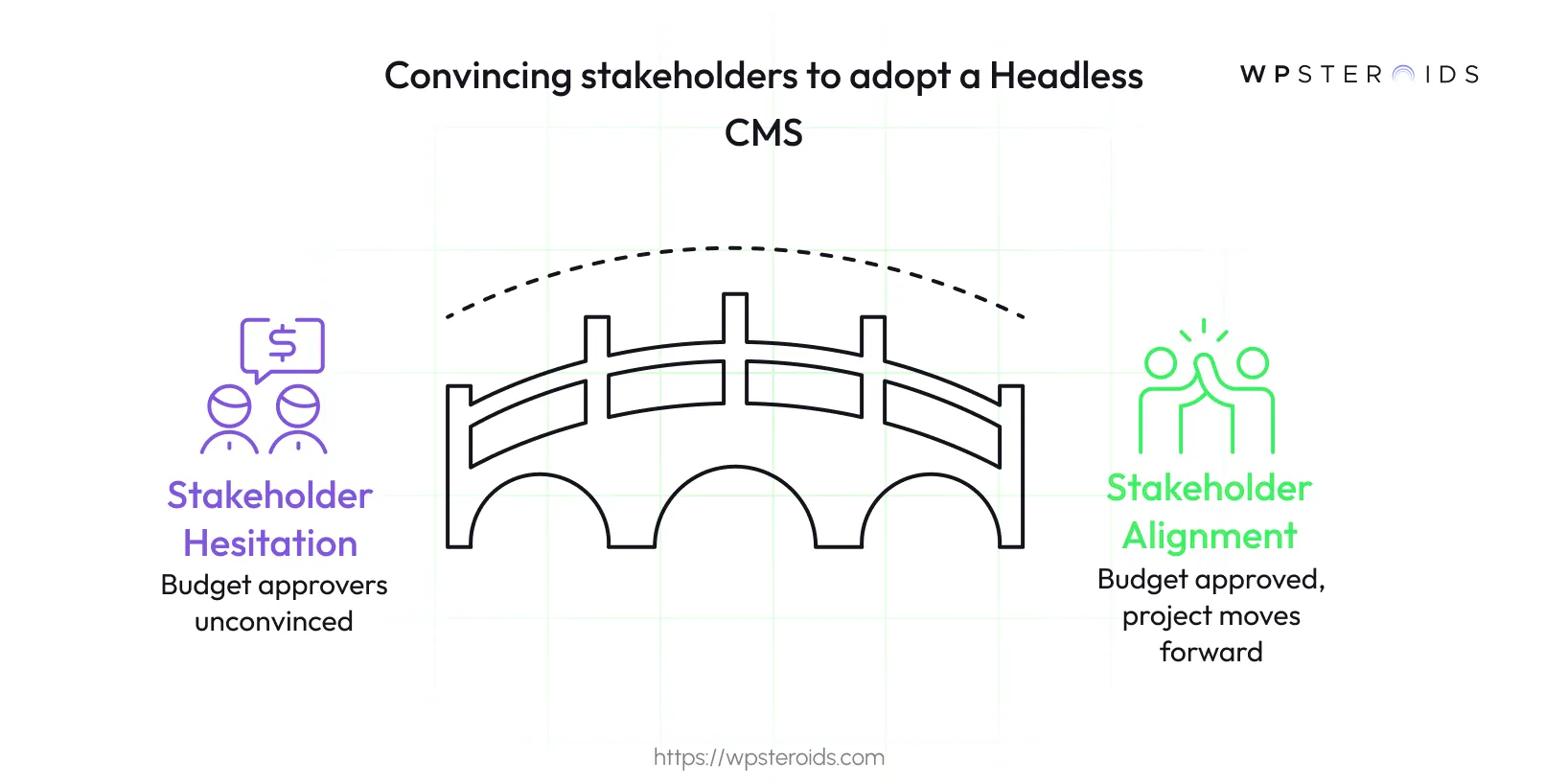
The move to headless is happening, and building a strong business case is the first step to ensuring your organization leads the change instead of reacting to it.
You're likely familiar with the concept of a Content Management System (CMS)—it’s the engine that powers your company website, the place where your marketing team goes to publish articles and update landing pages.
For years, platforms like WordPress have defined what a CMS is. But the "headless" approach fundamentally rethinks the entire model, and understanding this difference is the first step in appreciating its strategic value.
A traditional CMS is often described as a "monolithic" system. This is because its two primary functions are fused together: the back end, where content is created and stored (the "body"), and the front end, where that content is displayed to users (the "head," i.e., the website).
The content, its layout, and its design are all intertwined. For instance, a blog post is created in the back end, but it's structured from the start with the explicit purpose of becoming a page on your company's website. This tightly-coupled architecture works perfectly fine if your website is the only digital channel you care about.
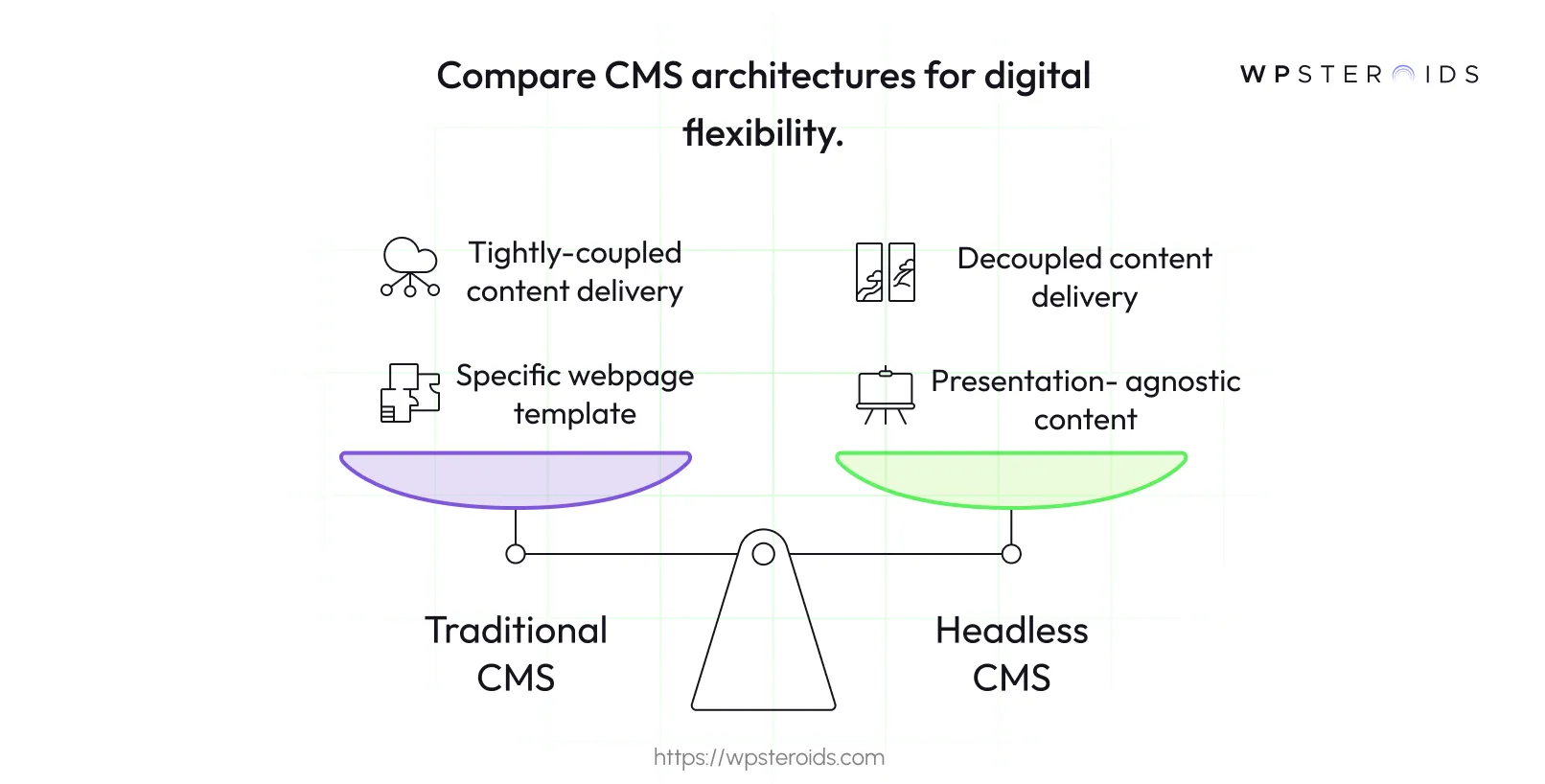
A headless CMS, on the other hand, decouples these two parts. As the name implies, it "cuts off" the front-end "head." What remains is a powerful, centralized content repository—the "body"—that does one thing exceptionally well: it stores, manages, and organizes your content in a raw, presentation-agnostic format.
It doesn’t know or care what the final destination looks like. Instead of being locked to a specific webpage template, this content is delivered on-demand via an Application Programming Interface, or API. An API simply acts as a secure, standardized communication channel that allows any front-end application to request content from the CMS.
This architectural shift from coupled to decoupled is far more than a technicality for the IT department; it is a critical business decision. The traditional, monolithic model forces companies into a website-centric mindset where content is stuck in a silo.
If you want to use the same marketing copy from a webpage in a mobile app, a team member often has to manually copy, paste, and reformat it for the new destination. This is inefficient, prone to errors, and leads to brand inconsistencies across channels.
Moving to a headless architecture marks a strategic evolution from a single-channel to an omnichannel-ready operation. You shift from thinking in "pages" to thinking in "structured content blocks".
That "product announcement" is no longer just a component of a webpage; it becomes an independent piece of structured content with a headline, a body, an image, and a call-to-action. As a reusable asset, it can now be pulled into any experience, ensuring consistency and drastically reducing manual effort.
This leads us to the single most important advantage that forms the foundation of a modern headless cms business case: the ability to create content once and publish it everywhere (a concept often abbreviated as COPE).
That one "product announcement" block we just discussed can now be delivered seamlessly by the API to all of your digital touchpoints simultaneously:
This capability is the key to creating a truly unified and efficient digital presence. It's how you ensure brand consistency everywhere your customers interact with you, and how you gain the agility to launch new experiences without having to rebuild your entire content infrastructure each time.
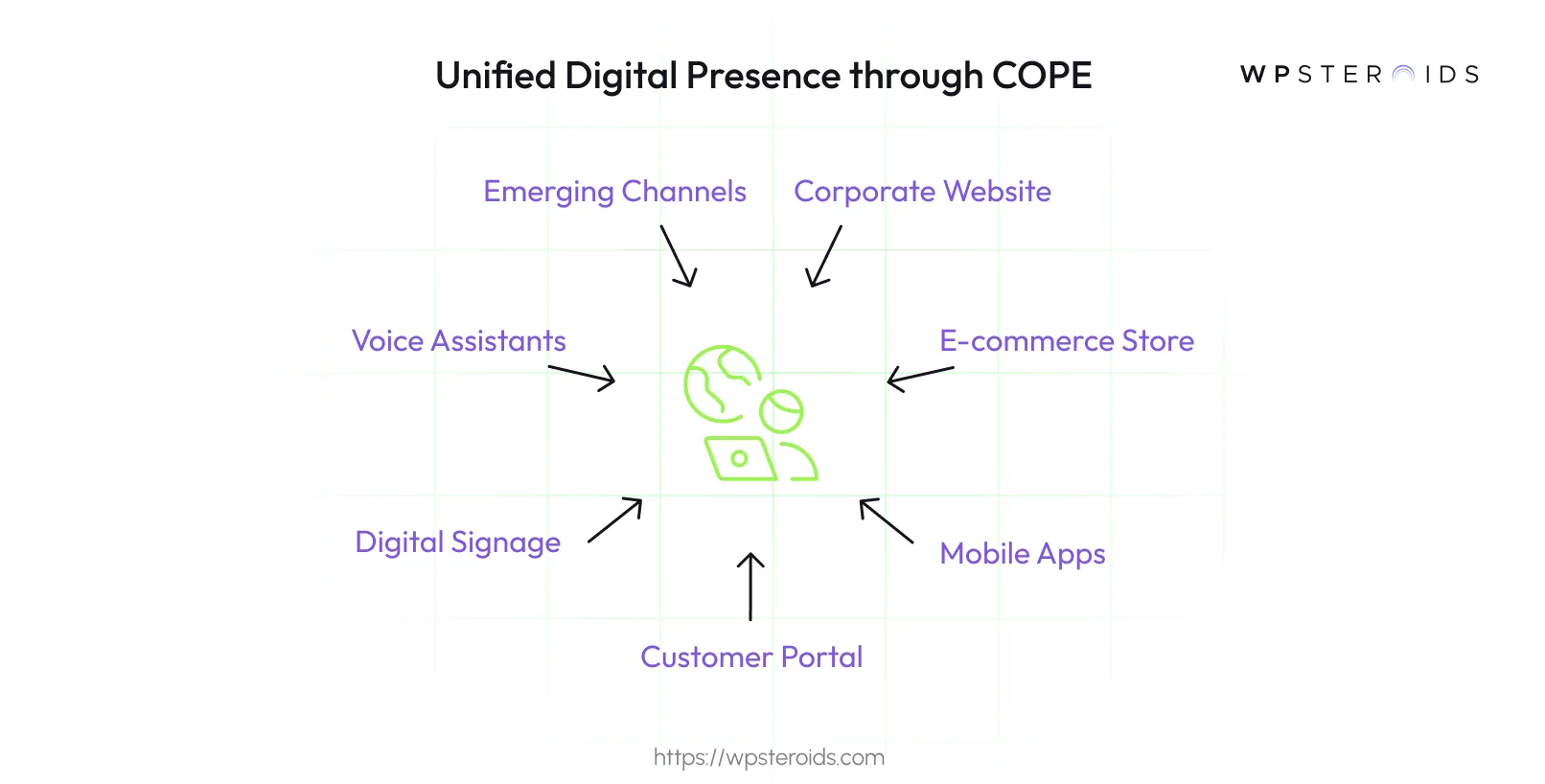
But, a powerful business case for a headless CMS isn't one-size-fits-all; it must speak to the distinct priorities of each stakeholder in your organization. What excites your development team will be different from what convinces your finance or marketing leads.
While the business case needs to extend beyond the IT department, winning over your technical leadership and developers is a critical first step.
A headless architecture fundamentally changes how they work for the better, empowering them to deliver results faster and more securely. Here are the key benefits you should highlight.
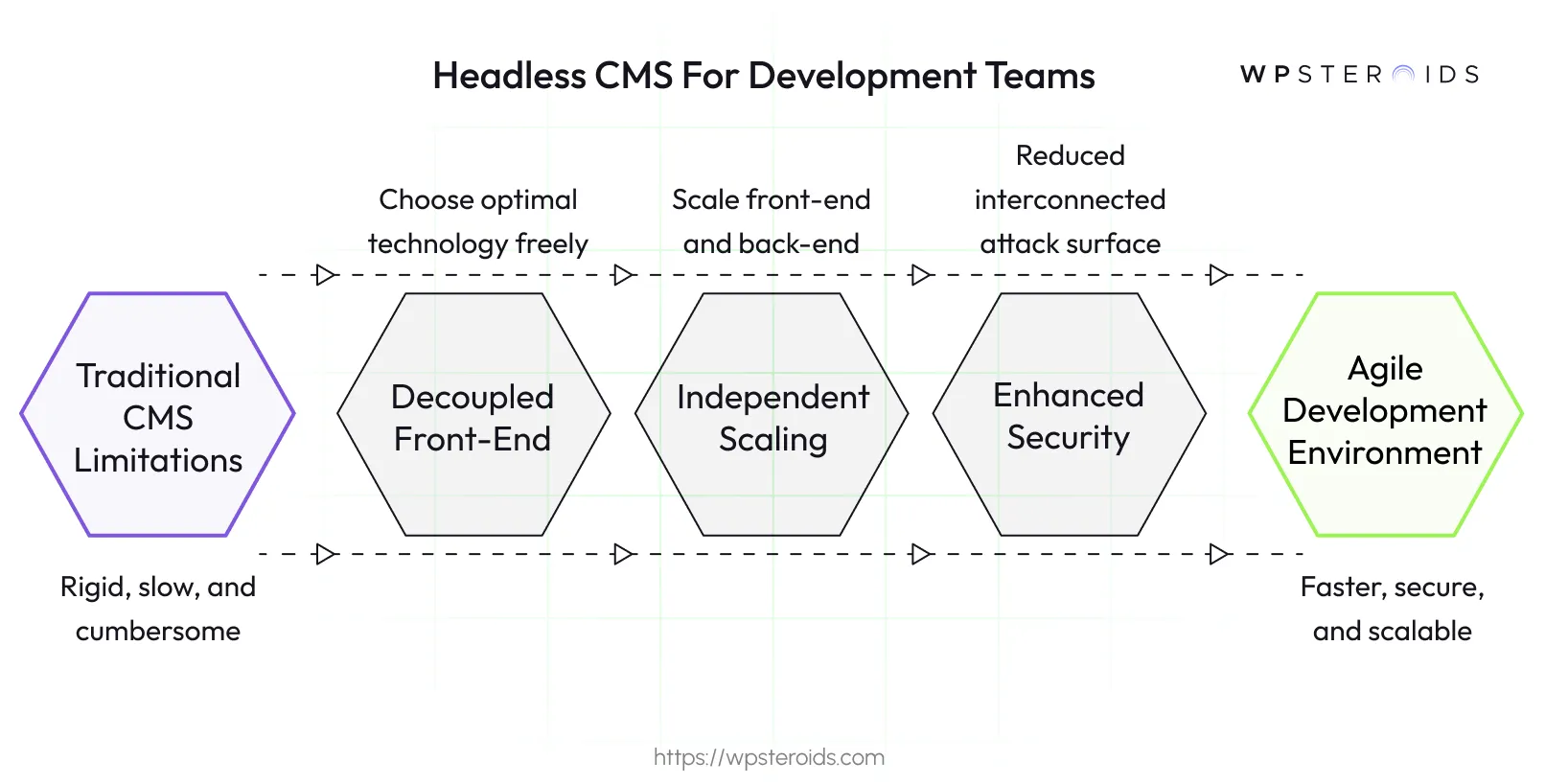
With a traditional CMS, developers are often forced to work within the confines of a rigid, proprietary technology stack and templating system. This can be slow, cumbersome, and prevent them from using modern, more efficient tools.
A headless CMS removes these handcuffs. Because the front end is decoupled, developers have the freedom to choose the best technology for the job.
They can use popular, high-performance frameworks like React, Vue, or Next.js to build lightning-fast user experiences.
This freedom isn't just about developer happiness; it directly translates into faster development cycles, quicker feature rollouts, and the ability to innovate on a dime—all of which give your business a competitive edge.
This architectural freedom allows your technical teams to craft user interfaces using any technology they see fit, ensuring the best possible performance and brand alignment for every digital channel.
One of the most significant but often overlooked benefits is the improvement in security.
In a traditional monolithic CMS, the back-end administrative panel, content database, and public-facing website code often reside in the same environment. This creates a large, interconnected "attack surface," making it more vulnerable to common web threats.
By decoupling the architecture, a headless CMS dramatically reduces this risk. The content management back end is separated from the front-end presentation layer.
This means your content database isn't directly exposed via the public-facing server in the same way, effectively walling off your most valuable assets and making it much harder for bad actors to compromise your system.
Your business is going to grow, and your technology needs to grow with it. An API-first headless architecture is inherently more scalable than a monolithic one.
Consider a major event like a Black Friday sale or a viral marketing campaign that drives a massive, sudden spike in website traffic.
With a traditional CMS, you often have to scale the entire system—the content management functions, the database, and the front end—which is both expensive and inefficient.
With a headless CMS, the front end and back end can be scaled independently. This means you can devote resources specifically to the user-facing application to handle the traffic spike without touching or over-provisioning the back-end content repository.
This targeted scalability is more resilient, more efficient, and far more cost-effective.
While the technical advantages are clear, they are ultimately a means to an end. For business and marketing leaders, the "why" behind a headless CMS is all about achieving core business objectives faster and more effectively.
This is where your business case starts to connect with the company's bottom line.
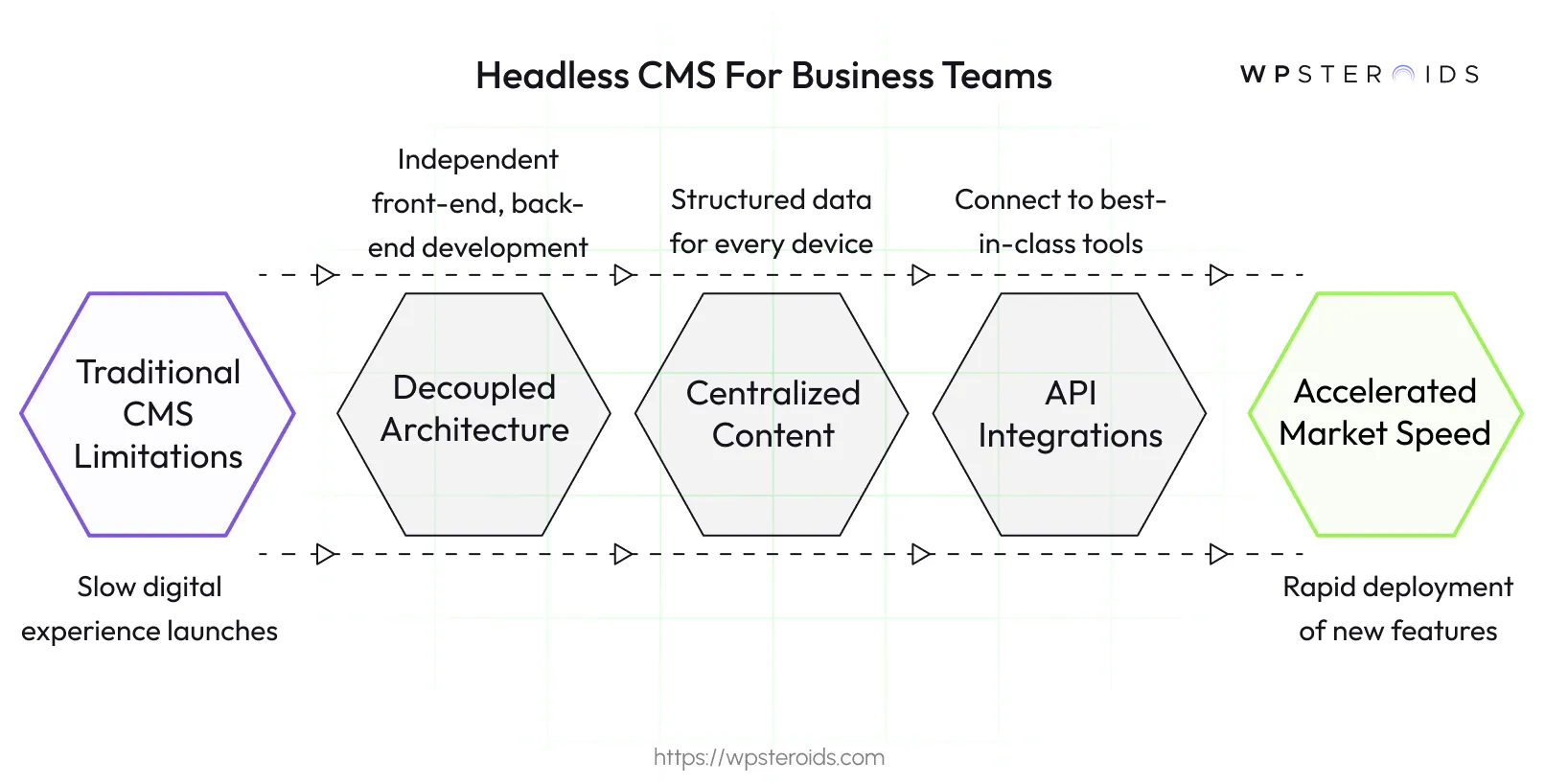
In today's fast-paced digital landscape, speed is a significant competitive advantage. A headless architecture empowers your teams to launch new digital experiences and marketing campaigns at a velocity that is often impossible with a traditional CMS.
Because your developers can build front-end experiences independently of the back-end content repository, the process of creating a new microsite for a product launch or a set of landing pages for a new campaign is dramatically streamlined.
Enterprises using this approach can deploy changes and new features far more rapidly, moving from idea to execution in days instead of weeks or months. This means you can react to market trends, launch targeted promotions, and get your message in front of customers while it's still relevant.
Today's customer journey is fragmented. A customer might see a product on Instagram, research it on their laptop, and check for stock on a mobile app before buying it in-store.
A headless cms case rests on its ability to deliver a consistent and coherent brand message across every one of these touchpoints. By treating your content as centralized, structured data that can be delivered to any device, you ensure the messaging, branding, and core information are uniform everywhere.
This eliminates the brand-damaging inconsistencies that arise when teams are manually copying and pasting content into different systems, creating a seamless and trustworthy experience for your customers, which is a key driver of brand loyalty.
A modern digital strategy isn’t just about being present on multiple channels; it’s about delivering the right content to the right person at the right time. A headless CMS excels here because its API-first nature makes it designed to integrate with other best-in-class tools.
For example, a returning visitor can be greeted with content and offers based on their previous browsing history, significantly increasing engagement and the likelihood of conversion. The conversion benefits are compounded because improved site speed is a natural byproduct of high-performance headless front ends.
Well, for the content creators, editors, and day-to-day marketing users, the idea of a headless CMS can sometimes sound intimidating.
The good news is that the industry has matured significantly, and a modern headless CMS can actually make their jobs easier, more strategic, and more efficient once they get past a few common misconceptions.
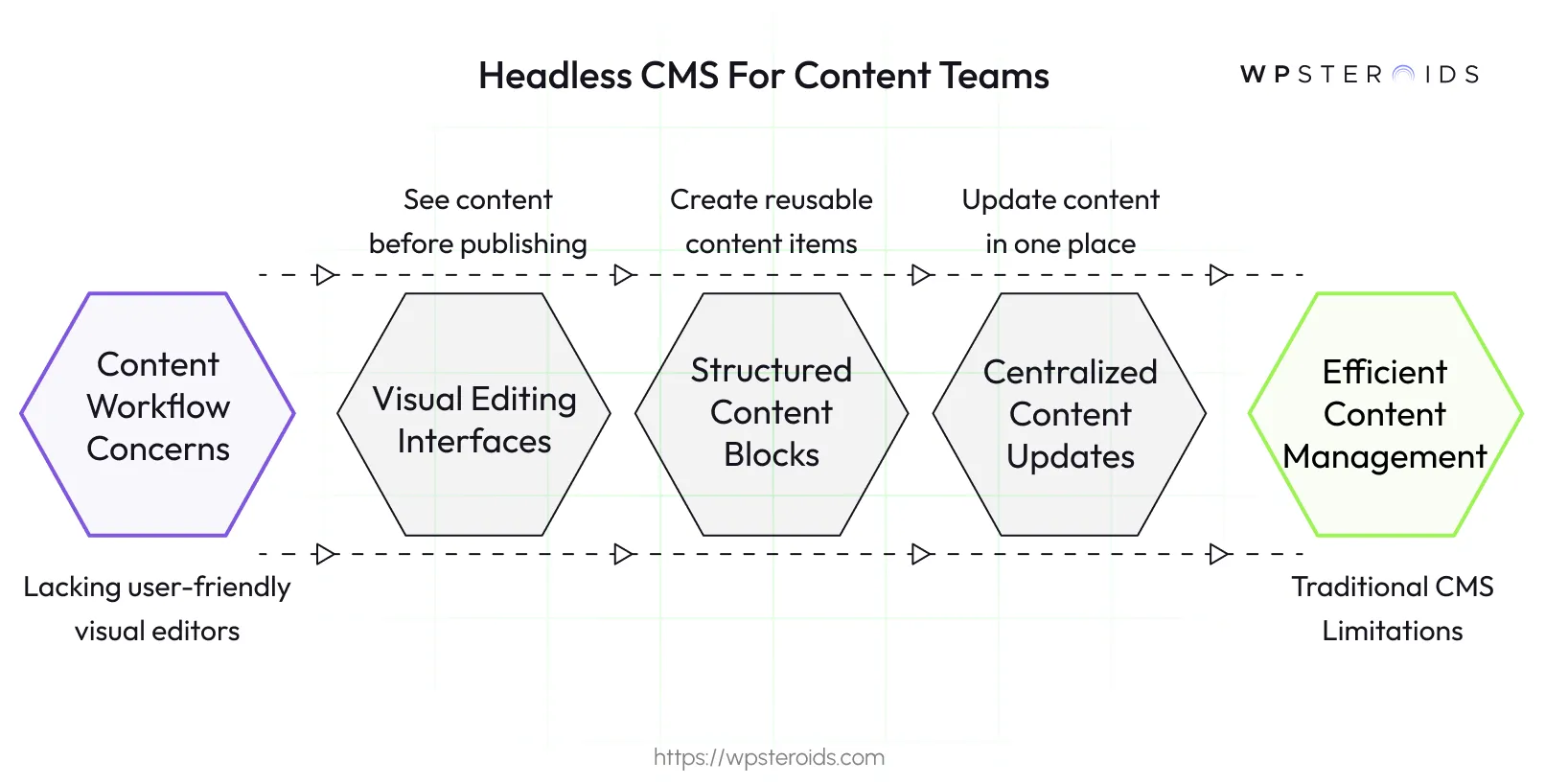
The most common fear I hear from content teams is: "Will I lose the user-friendly 'what you see is what you get' (WYSIWYG) editor that I'm used to?" This is a valid concern, as early headless systems were often little more than a database with a technical interface, offering no clear way to visualize how content would actually look.
However, the market has evolved specifically to solve this pain point. Many leading headless CMS vendors now provide sophisticated visual editing interfaces and robust content preview tools.
These features allow creators to see exactly how their content will appear on a webpage, a mobile app screen, or any other defined front end before they hit publish, removing the guesswork and providing the confidence they need.
Perhaps the most powerful long-term benefit for content teams is the shift from thinking in isolated "pages" to creating structured "content blocks." Instead of creating an "About Us" page and then later creating a "Meet the Team" page with much of the same information, you would simply create a "Team Member" content item.
This item would have structured fields like Name, Title, Biography, and Headshot. This single, reusable content block can then be pulled automatically into the "About Us" page, speaker bios for a webinar announcement, or the byline of a blog post.
The efficiency gain here is enormous. When a team member's title changes, you update it in one place, and it instantly populates correctly everywhere it's used. This dramatically reduces time spent on repetitive manual updates and eliminates the risk of embarrassing inconsistencies.
For executive leadership, the conversation ultimately comes down to the numbers. While speed and scalability are great, the business case for headless cms must be grounded in a clear financial model.
The move to headless is not just a technology upgrade; it's a financial investment that can be justified through both cost reductions and revenue growth.
To make a compelling argument, we need to translate the benefits we've discussed into a tangible forecast for Return on Investment (ROI).
This means looking at both sides of the financial ledger: how a headless CMS will save the company money, and how it will help the company make more money.
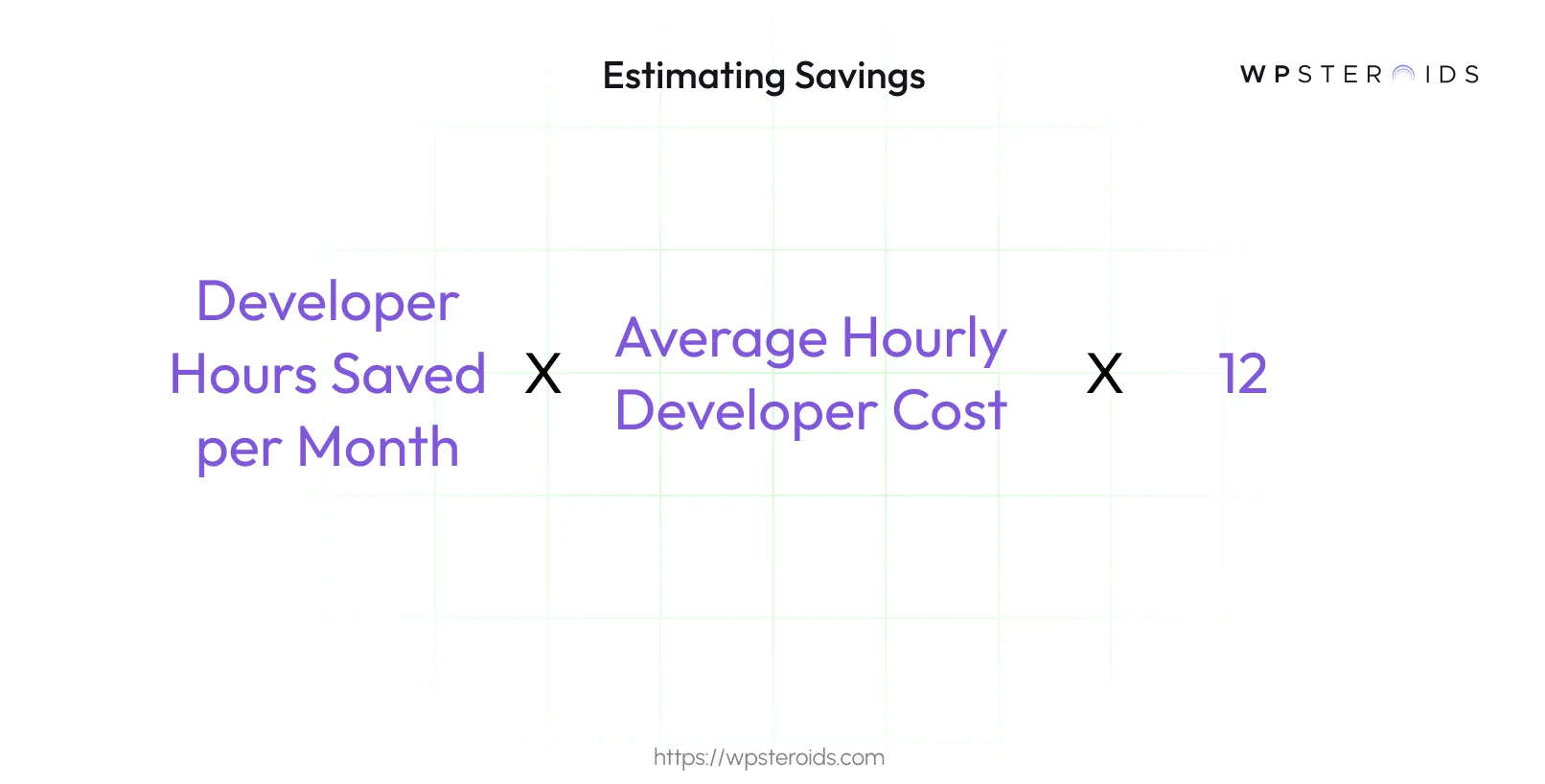
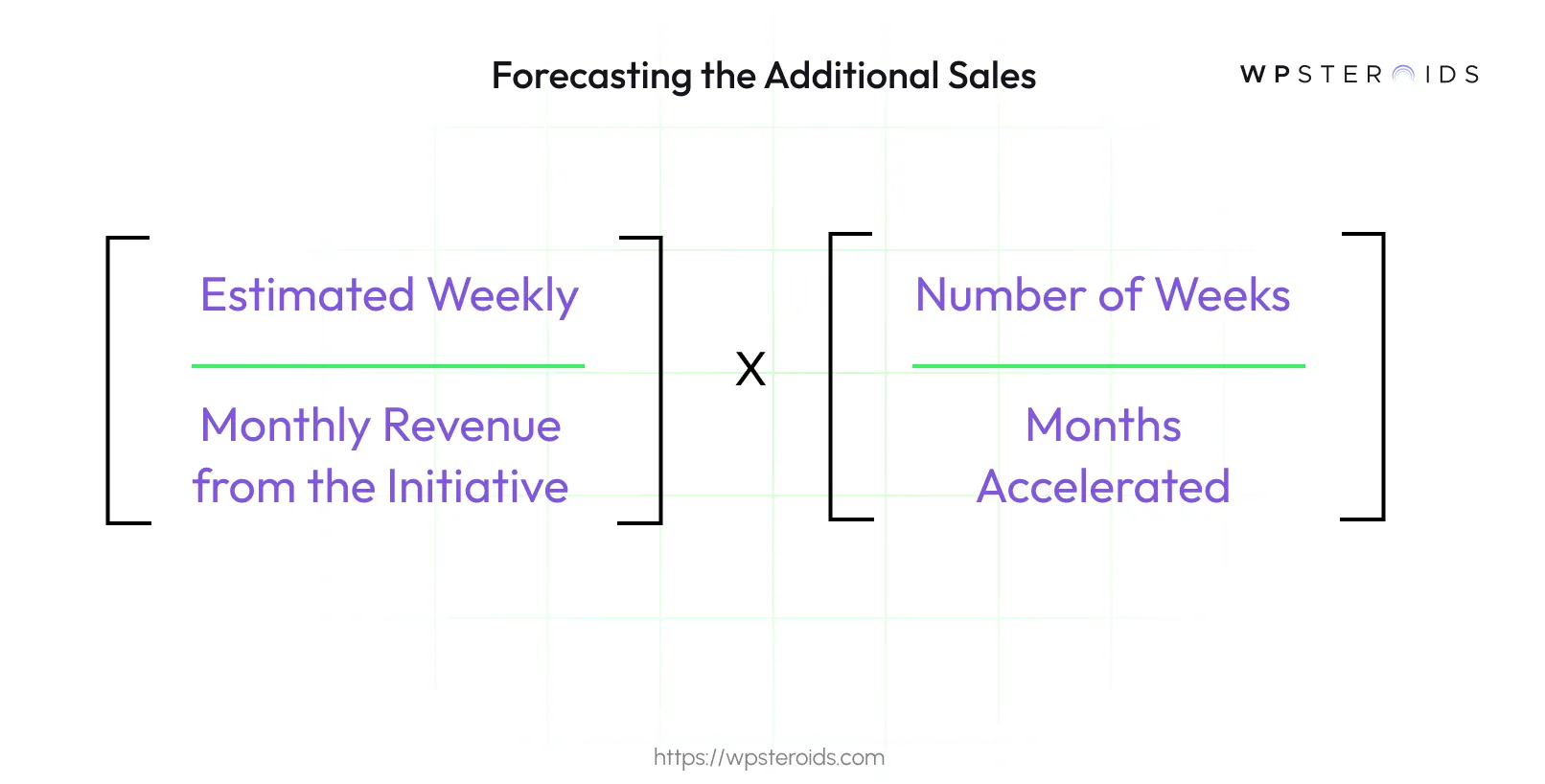
To present this information clearly, I recommend creating a simple spreadsheet that outlines each of these points.
By projecting these figures over three to five years and comparing them to the total cost of ownership (TCO) of the new system, including subscription fees, implementation costs, and training, you can present a clear, data-driven argument that speaks directly to the financial priorities of your leadership team.
A strong business case requires a clear budget, and a significant portion of that will be the CMS platform cost. Understanding Strapi's transparent pricing for both its managed cloud and self-hosted enterprise editions can provide the concrete figures needed for your financial projections.
It’s powerful to see how other companies have navigated this transition. Many have found success creating composable member platforms and B2B customer portals using a headless CMS.
But to avoid focusing on just one vendor's clients, let's look at a couple of other industry examples.
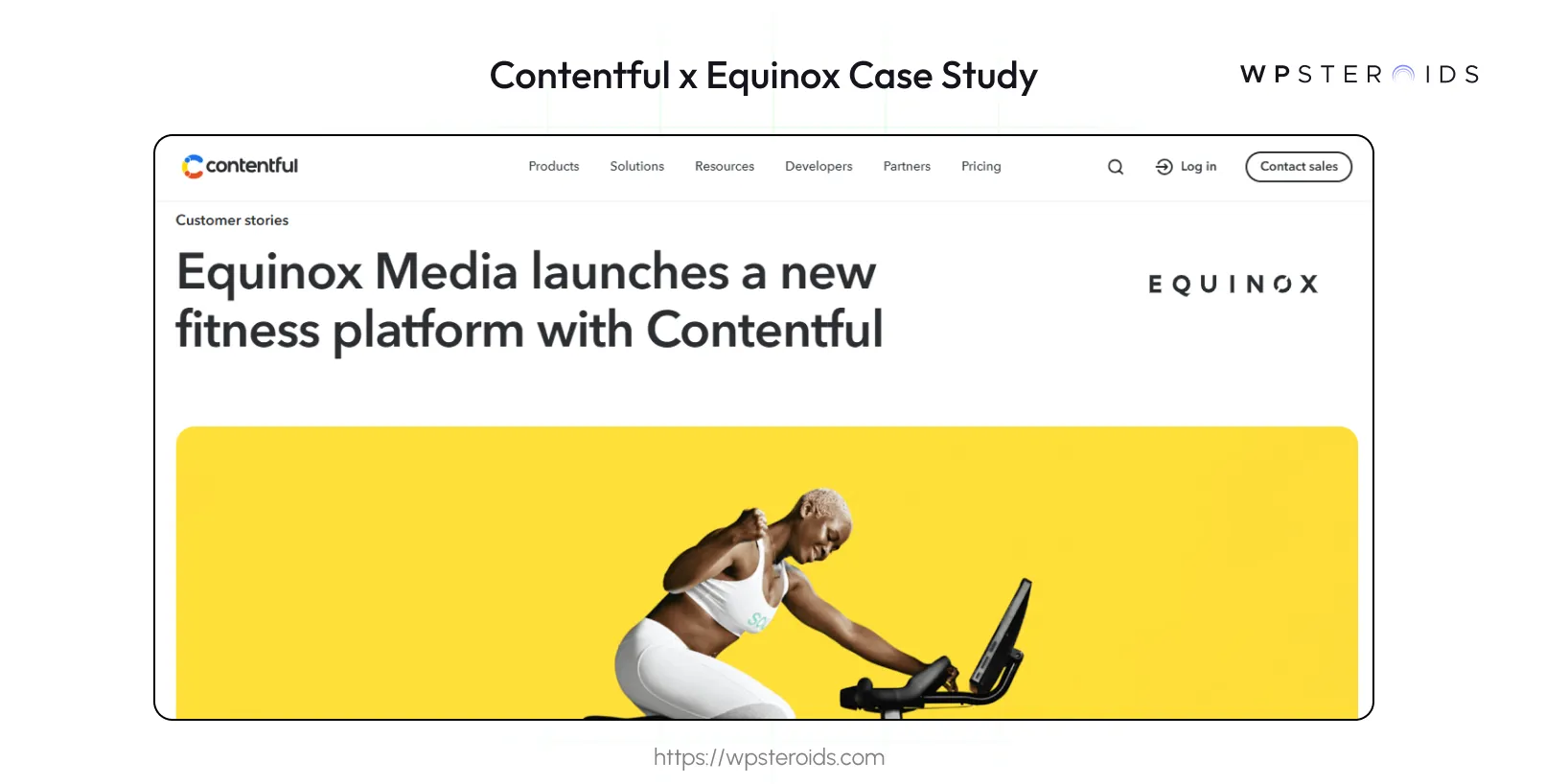
Each brand had its own siloed content and technology stack, making it impossible to share content or present a unified brand identity to a member who might interact with multiple Equinox services.
A customer's experience in the app felt disconnected from the fitness club, leading to a fragmented journey. Their legacy systems were slow and required heavy developer involvement for even minor content updates, hindering their ability to innovate and respond to member needs.
Instead of creating pages, they created "intents"—like "Find a class" or "Book a trainer." These intents could be populated with content from across their brands (e.g., a SoulCycle class and an Equinox trainer) and delivered seamlessly to any front-end application, starting with the Equinox+ app.
This modular approach allowed them to mix and match content to create personalized and cohesive experiences for their members. The impact was profound. By implementing Contentful, Equinox was able to increase the velocity of its feature releases by three to four times.
This new agility allowed them to quickly launch revenue-driving initiatives, such as a feature that increased member-to-member interactions within the app by 15%. Most importantly, they began to break down internal silos and operate as a unified "One Equinox."
This case study is a powerful illustration of how a headless CMS can be used to solve brand fragmentation, increase development speed, and ultimately deliver a more consistent and engaging customer journey in a complex, multi-brand environment.
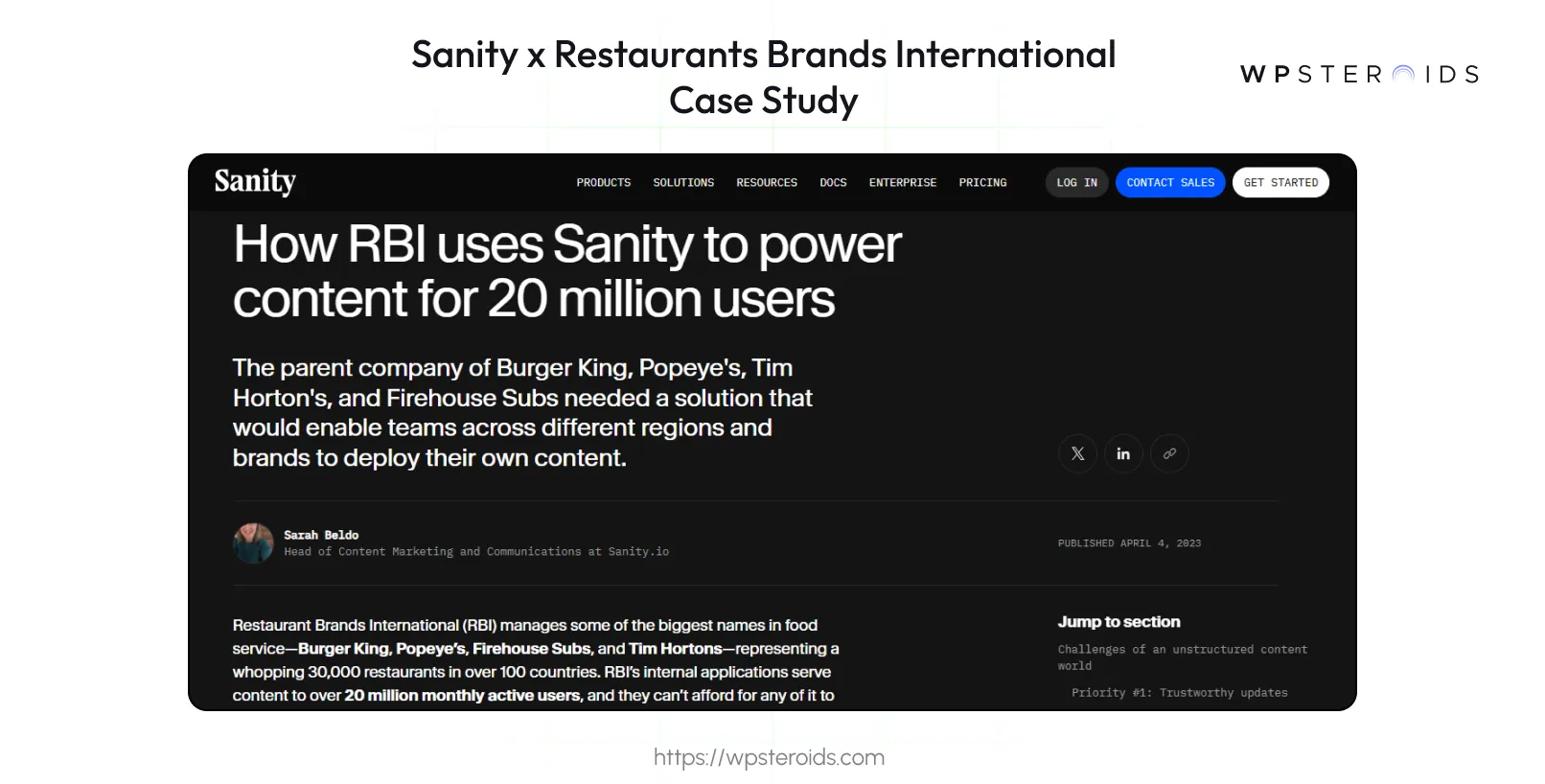
Restaurant Brands International (RBI), the parent company of Burger King, Popeyes, and Tim Hortons, operates in a fast-paced global market where marketing campaigns need to launch frequently and flawlessly across multiple countries and languages.
Their digital agency partners faced the immense challenge of quickly spinning up campaign websites and promotional materials that were both globally consistent and locally relevant. Their existing processes were not standardized, making it difficult to maintain brand control while giving local markets the flexibility they needed.
They used Sanity's highly customizable content modeling to define a library of structured components—from menu items and nutritional information to legal disclaimers. Critically, they implemented a content layering system.
A global "base" layer of content is managed by RBI's central team, while regional and local franchisees can override specific fields (like price or availability) for their specific market. This ensures that the core brand messaging and product information remain consistent, while still allowing for essential local adaptation.
The adoption of Sanity has fundamentally changed how RBI executes its digital campaigns. Local agencies can now self-serve, launching fully on-brand websites in hours instead of weeks, with minimal developer involvement.
For one Popeyes campaign, they were able to get over a hundred localized sites live in under a day. This has given RBI an unprecedented level of agility, allowing it to capitalize on fleeting market opportunities and run more creative, targeted promotions.
The case demonstrates how a structured, headless CMS can solve complex governance and localization challenges, enabling a global enterprise to operate with speed and consistency at scale.
A smart business case is an honest one. To build credibility and get genuine buy-in from stakeholders, it's essential to present a balanced view that acknowledges the investment required and the potential hurdles ahead.
Let's be transparent about the real costs and challenges so you can plan for them effectively.
One of the most important things to be transparent about is that the subscription or license fee for the CMS is not the full picture of your investment. A credible financial plan must look at the Total Cost of Ownership (TCO), which includes necessary development resources.
A "pure" headless CMS is intentionally lean; it’s designed to manage content, not handle complex business rules on its own. It is common practice to build a separate, custom service that sits between the CMS and the front end to handle processes like user authentication or e-commerce transactions.
Your business case must therefore account for the development time and expertise needed to build and maintain this intermediate layer. This isn't an unforeseen issue but a standard part of a headless architecture that needs to be factored into the budget from day one.
Acknowledging risks is the first step, but a strong proposal shows you have a plan to address them. The main challenges in a headless transition are operational and strategic, but they can be successfully managed with proper planning.
First, a headless transition is a significant project that requires careful coordination between developers, marketers, content creators, and leadership. Your implementation plan must include dedicated time and clear roles for this cross-functional collaboration to succeed.
Second, because a headless approach changes how content is made, you will need a new process for managing it. The shift to structured content requires defining new content models, clear editorial workflows, and updated approval processes to ensure quality and consistency.
Once stakeholder buy-in is achieved, the next phase involves technical evaluation. To help your development team get started, you can share our comparison of the top open-source platforms designed for building modern digital experiences.
Finally, selecting the right technology partner is the single most effective way to mitigate many of these risks. I recommend creating a vendor-agnostic evaluation framework to compare your options, using a checklist to score platforms on these key criteria:
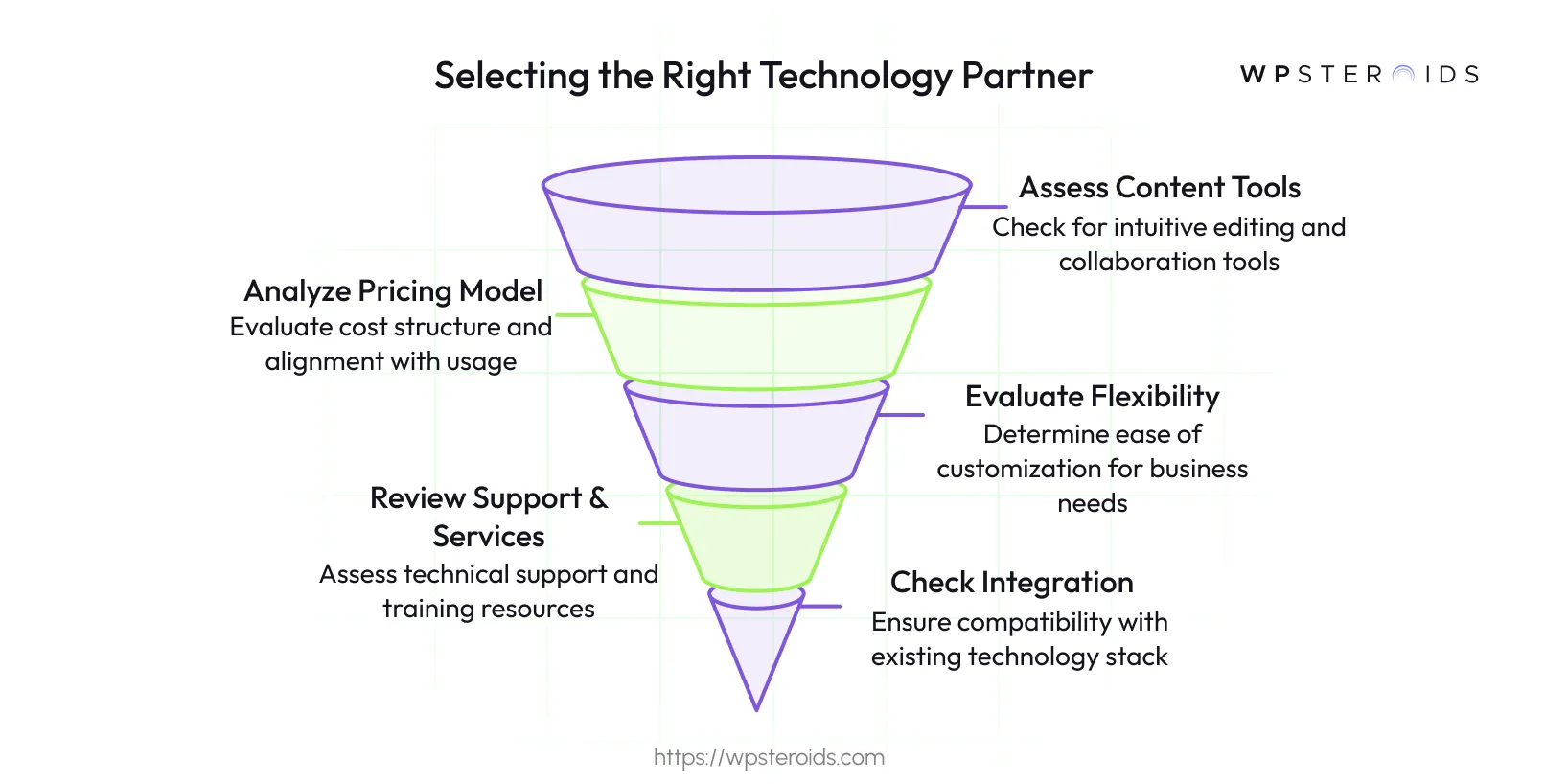
As we've seen, building a successful business case for a headless CMS is about telling a complete story. It's about connecting the dots between advanced technology and tangible business outcomes.
You are now equipped with the key arguments to make that case. You can articulate how this move enables true omnichannel marketing, how it future-proofs your digital strategy, and how it increases developer efficiency, all while building toward a strong, positive Return on Investment (ROI).
Once your organization has approved the business case for going headless, the next crucial step is the technical selection process. This technical guide to the best headless CMS for developers provides the framework your team needs to choose the right platform.
The decision to adopt a headless CMS is no longer just about gaining a competitive edge; it's about not being left behind by more agile competitors. Waiting on the sidelines is becoming a strategic risk.
Consider this guide your blueprint. Use the frameworks inside to assemble a business case tailored to your organization’s unique needs, equipped with both the compelling benefits and a clear-eyed view of the challenges. You have the information needed to start the conversation and lead your company into a more flexible and powerful digital future.
